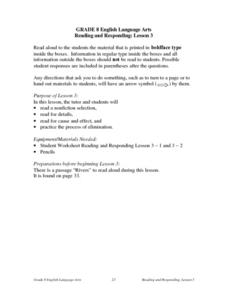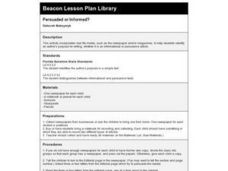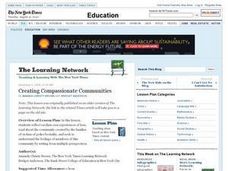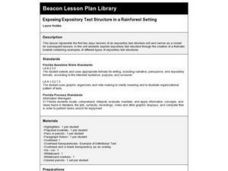Curated OER
Geography of Canada
All about Canada! Learners explore the geography and providences of Canada by watching videos, studying maps and conducting internet research. By the end of this lesson, your class should be able to locate major areas and compare and...
Curated OER
Chemical Equations
Wow! This comprehensive collection of slides will walk your chemistry class through the foundation of chemical reactions, teach them to balance equations, differentiate types of reactions, and calculate stoichiometry problems. This...
Curated OER
Reading and Responding: Lesson 3
Reinforce comprehension of informational text. This is a one-on-one lesson intended to build an internal dialogue the reader can use to boost overall comprehension. They work independently with a tutor or teacher to read a nonfiction...
Curated OER
Persuaded or Informed?
Give each learner a newspaper for this lesson! As a group, read select editorials and discuss them with your class. Are these articles informational or persuasive? Cut out select editorials and have learners identify the purpose of each...
Curated OER
Introduce Vocabulary: Dinosaur Bones (Barner)
Dig into some prehistoric vocabulary in Bob Barner's informative book Dinosaur Bones. This works best if you introduce the primitive words before reading the story. These are the focus terms in the text: ancient, climate, extinct,...
Curated OER
Is That Movie OK?
Discuss movies and movie enjoyment with your middle school language arts class. They interpret movie review information, determine appropriate movies, and then write film reviews to share with the class. Focus on using context clues to...
American Museum of Natural History
Make Your Own Earth Stationary
Scholars follow five steps to make personalized Earth-themed stationary. Personalization includes name and returns address.
Curated OER
Creating Compassionate Communities
Have you ever lost someone? Middle and high school learners journal about a time they experienced the loss of someone through death, divorce, moving, or another type of change. They share their responses and discuss an article relating...
Curated OER
Acid Rain
Create a simulation of acid rain in your classroom with lemon juice and bean plants to help kids study the effects of pollution on plants. In addition, learners will listen to a story and write responses based on guiding questions.
Curated OER
Sun and Shadows
Why do shadows look different in the summer than in the winter? What causes day and night? How can a sundial be used to tell time? Answer these questions and more through two engaging lessons about light and shadows. Fourth and fifth...
Maryland Department of Education
The Concept of Identity Lesson 7: Logical Fallacies
What are the effects of competition in an academic environment? The competition between the main characters in A Separate Peace motivates a series of activities that asks readers to take a stance on competition, and then to develop a...
K5 Learning
May the Best Prankster Win
Everyone loves a good prank! With this reading passage, Perla and her grandmother play some fun innocent pranks on one another. Kids focus on new vocabulary words, questions about the information they have read, and responding with their...
Curated OER
Creature From The Deep
Students become familiar with oceanography terms by writing an oceanography horror story.
Curated OER
Compare and Contrast Versions of a Story
Compare and contrast reading passages with the ever favorite story of Cinderella. The versions in focus include an Italian version and a Native American story followed by three questions designed to share similarities and...
Orlando Shakes
Shakespeare in Love: Study Guide
What word has two syllables and means a ray of moonlight? If young readers guessed moonbeam, they are correct! With the Shakespeare in Love study guide, participants test their guessing skills in an exciting game of Shakespeare Taboo...
MOST
What Are Cells?
What's in a cell, anyway? Kids read informational text on what makes up both animal and plant cells, including a page of vocabulary terms they will need to be familiar with (cytoplasm, ribosomes, vacuoles, etc.). Full-color images...
Roald Dahl
The Twits - The Furniture Goes Up
Work gets done faster when people work as a team. The ninth installment of an 11-instructional activity unit designed to accompany The Twits by Roald Dahl combines character education with research skills and creative writing activities....
Curated OER
Exposing Expository Text Structure in a Rainforest Setting
Students create a thematic booklet containing examples of different types of expository text structures. They explore a variety of expository text structures.
Curated OER
A Little Mystery and Intrigue in Writing Short Detective Stories
Learners read and analyze the twelve short stories in the novel "The Adventures of Sherlock Holmes." They create their own detective that has to solve a new kind of crime, and write and edit a short story with their original detective as...
Curated OER
Journal Writing
Students gain a better understanding of good journal writing. They examine how there are two types of journals - personal and public, yet each serves to describe the writers feelings and experiences about a given event.
Curated OER
Research/Technical Writing: Paraphrasing
Students work in groups to paraphrase an article. In this paraphrasing lesson, each group is assigned a paragraph to paraphrase in one sentence. Other groups critique the sentences to make sure each is effective. ...
Curated OER
Dinosaur reports-4 blocks guided reading & focused writing (Elementary, 4 Blocks)
Young scholars read books about dinosaurs for book club groups and then participate in focused writing. In this reading and writing lesson, students work together over the course of three days to produce a group story about a dinosaur.
Curated OER
Trace and write number 11
In this number 11 instructional activity, students trace and write the number 11 to practice writing it. Students trace it 8 times and write it 81 times.
Curated OER
Trace and Write: Number 10
In this number 10 worksheet, students trace and write the number 10. Students trace the number 18 times and write it 80 times.























